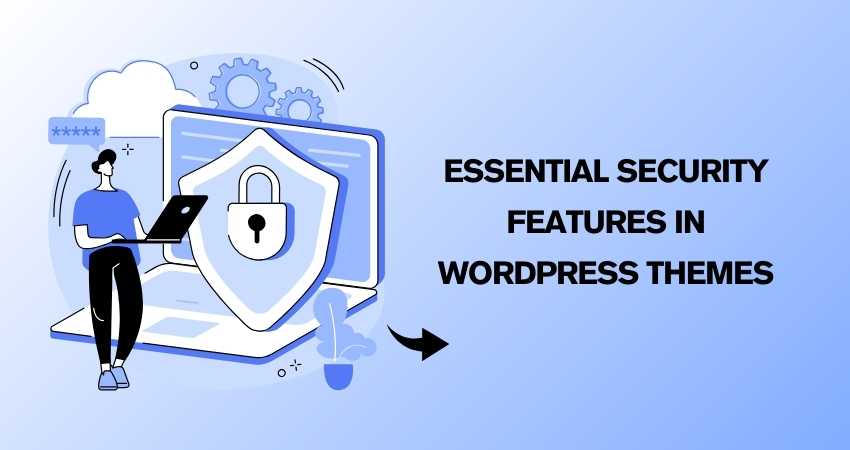About 40% of website owners use WordPress, the most cost-effective and popular CMS available today. It’s popular because it’s flexible, user-friendly, and has many themes and plugins. This is why hackers keep an eye on WordPress websites, as millions of website owners are its users. That’s why focusing on security is crucial, especially regarding your WordPress theme.
In this article, we’ll explore the must-have security features for WordPress themes and suggest some handy security plugins to help keep your site safe.
Why Theme Security Matters
WordPress themes aren’t just about looks. They also play a significant role in your site’s security. If your theme has weak spots, it could leave your site vulnerable to attacks. Many businesses avoid implementing must-have plugins like Wordfence, which helps us to identify login attempts, protect from DDoS attacks, and many more. One mistake often made by most users is installing nulled themes that always come with injected scripts. Let’s know how to protect your website from further attacks.
Top Security Plugins for WordPress
- Wordfence Security
Wordfence is a top choice for many WordPress users. It offers firewall protection, malware scans, login security, and real-time threat defense. - Sucuri Security
Sucuri provides malware scanning, monitoring, and cleanup. It also offers a website firewall (WAF) to protect against online threats. - iThemes Security
Previously known as Better WP Security, iThemes offers tools like malware scanning, file integrity checks, and brute force protection. - All-In-One WP Security & Firewall
This plugin provides a complete suite of security features, including firewall protection, login lockdown, and database security. - SecuPress
SecuPress is user-friendly, protects against brute force attacks, blocks suspicious IPs, and scans for malware. - BulletProof Security
BulletProof offers malware scanning, firewall protection, and database backups, making it a solid choice for beginners and advanced users. - Shield Security
Shield Security focuses on simplicity while offering login protection, brute force prevention, and file integrity monitoring. - Security Ninja
Security Ninja runs over 50 security tests to identify vulnerabilities in your WordPress setup and provides actionable recommendations. - Jetpack Security
Jetpack offers a range of security features, including downtime monitoring, brute force protection, and malware scanning, all managed from one place. - WP Security Audit Log
This plugin tracks all changes and user activity on your site, providing detailed logs and real-time alerts to help you keep your site secure.
Key Security Features for WordPress Themes
- Code Quality and Regular Updates
High-quality code is your first line of defense. A well-coded theme is less likely to have vulnerabilities. Regular updates are also crucial, as they patch security holes and keep your theme compatible with the latest WordPress version. - Secure Authentication and Access Controls
Use secure authentication methods like two-factor authentication (2FA) to protect your WordPress admin dashboard. Enforce strict access controls to ensure only authorized users can make changes. In most cases, 2FA is the only solution that stops websites from being accessed by unknown users. - Cross-Site Scripting (XSS) Protection
XSS attacks are common but preventable. To block malicious scripts, ensure your theme sanitizes and validates user inputs. Adding security headers like Content Security Policy (CSP) can reduce the risk of XSS attacks. - SQL Injection Prevention
SQL injections target your site’s database. Protect against these attacks by using prepared statements and parameterized queries in your theme’s code to prevent them. Also, always validate user inputs. - Cross-Site Request Forgery (CSRF) Protection
CSRF attacks trick users into executing unwanted actions. Protect your site by using nonce (number used once) verification in your theme’s forms and actions. Ensure these tokens are unique and validated on the server side. - Secure File Handling and Uploads
Prevent hackers from uploading malicious files by enforcing strict file upload rules. Use WordPress’s built-in functions to handle and validate files, ensuring they pass rigorous security checks before processing. - Data Encryption and HTTPS Support
Encrypting sensitive data like user credentials and payment information is crucial, as millions of customers shop online. For any theme you buy, ensure it supports HTTPS, encouraging site owners to install SSL/TLS certificates for secure, encrypted connections. - Role-Based Permissions and Privileges
Implement role-based access control (RBAC) to assign permissions based on user roles. Restrict access to sensitive areas of your theme to minimize the risk of unauthorized changes. - Secure Theme Customization and Third-Party Integrations
Support child themes and theme hooks to allow safe customizations. When integrating third-party services or plugins, ensure they meet WordPress coding standards and pass security checks.
Final Thoughts
Many successful D2C companies use WooCommerce, which millions of users love, so security is crucial in today’s digital world, especially for WordPress sites that are frequent targets for cyber-attacks. You’re responsible for safeguarding your site as a website owner or developer. You can secure your website with the following points. Talk to a professional expert if you believe your website has been compromised.
